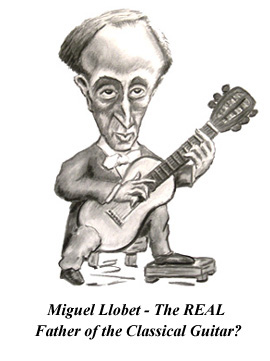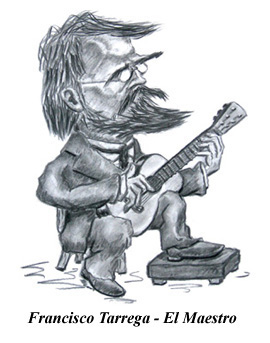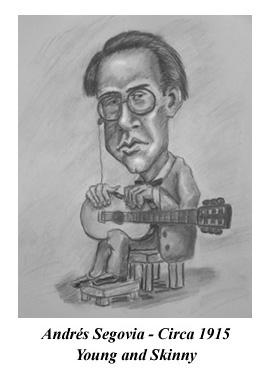Miguel Llobet
Will the Real Father of the Modern Classical Guitar Please Stand Up
(Or Sit Down and Play)?
Some musicologists and music historians believe
it is Miguel Llobet who deserves the accolade as the father of the
modern classical guitar. And in fact, prior to the First World War,
it certainly looked like Miguel was destined to elevate the rustic
folk instrument to a level equal to the choice instruments of men
like Kriesler or Paderewski (whoever they were). It might have even
turned out that way except that early on Miguel's reputation was
eclipsed by a (then) young and (at the time) skinny guitarist from
Andalusia, Andrés Segovia Torres.
As a young man Miguel studied with Francisco Tarrega, the guitarist and composer who is usually deigned as the pioneer of classical guitar technique and pedagogy (naturally prompting some to say it is Francisco who is really the father of the classical guitar). Segovia never knew Tarrega (who died when Andrés was sixteen), but he did meet Llobet. Exactly when and how often isn't really clear and to what degree Miguel's playing influenced the younger man is also debated. Naturally with the fondness for revisionist history so prevalent today, it's becoming fashionable to question Andrés' claim that he was completely self-taught and to suspect that he was something of a surreptitious student of Llobet's, however briefly. But in Segovia's autobiography (covering his life up to his late twenties), Andrés said he met Llobet around 1915. By that time Andrés was already a performing artist and had reached the age where a professional musician's skills are more or less developed. Jose Rey De La Torre, a Cuban guitarist who studied for two years with Miguel, also believed contact between Segovia and Llobet was limited and that Segovia probably didn't hear Miguel perform more than a few times.
Segovia himself seemed ambiguous about Miguel's playing, calling him a great artist and yet somehow downplaying his technique. People acclaimed Llobet's virtuosity, Andrés said, because they were astonished to find someone who could actually play scale passages rapidly and smoothly on the guitar. Miguel's tone, he also added, was subpar, being rasping and metallic and lacking resonance and fullness.
Rey took considerable exception to Andrés opinion, though, thinking Andrés' conclusion was formed from too limited exposure to Miguel's playing. While he was under Miguel's tutelage, Rey said, he never once heard tone that was rasping or metallic. On the other hand, Miguel's surviving recordings will probably not strike the listener as anything extraordinary; certainly not by today's standards of virtuosity nor when compared to recordings that Andrés made around the same time. But to be fair to Miguel, Segovia himself thought Llobet's recordings were so far below the quality of his usual playing that they should be destroyed.
Be that as it may, Miguel was the first guitarist to give truly international (indeed, intercontinental) concert tours, and by the start of the first World War, Miguel had performed extensively in Europe and in South, Central, and North America. He made both acoustical records (that have not survived) and electric recordings (which have). Miguel was also a composer and arranger of considerable merit. His adaptations of the piano tunes of Isaac Albeniz - particularly the show pieces Sevilla and Granada - are essentially those played today (although he's not always credited as the arranger) and he wrote a series of tunes based on Catalan folk melodies that remain performing standards. But today virtually no one except die-hard classical guitar fans even know who he is. And yet everyone knows Andrés.
So what happened?
First, there was Segovia's sheer longevity
coupled with the relative technological changes that occurred during
the lives of the two men. Before the age of recording, a performing
artist's fame was short lived, and multi-generational renown was
rare. To obtain true musical immortality performing musicians also
had to have equal if not greater fame as a composer (like Mozart and
Beethoven). With some exceptions (like Caruso), even artists who
recorded only in the pre-Hi Fi days dropped from the musical radar
screen once LP's began to be released.
Miguel made his last records in the years from 1925 to 1929. But Andrés began cutting discs also in the mid-1920's and continued (literally) for half a century. Today you can get a Segovia recording almost anywhere, and you can bet that if anyone decides they want to get an introduction to classical guitar they'll grab something by Andrés.
But Miguel was also a composer. So why isn't he remembered as such? Well, Miguel's compositions are very specific works for the guitar. So you might hear Bach transcribed for guitar but you won't hear Llobet adapted for piano. And sad to say, among your Joe and Josephine Blows on the street, a classical guitar is still something of a novelty instrument and so most people do not put the guitar at the level of the choice instrument of Kriesler and Paderweski. (Just who the heck were those guys?)
But we can't really criticize Mr. or Ms. Average Citizen for not thinking of Miguel as a composer. Shoot, even many guitarists see Miguel as a performer first and a composer second. They will often refer to him as having harmonized the Catalan folk melodies (Miguel's most popular tunes) rather than composing tunes based on folk melodies. Such remarks were particularly irksome to Rey de la Torre, who wondered why men like de Falla and Vaughn Williams were composers who used folk tunes in their compositions, but Llobet was a mere (ptui) "arranger" or "harmonizer".
Moving on, we should also compare concert schedules and touring itineraries of Miguel and Andrés. Although Andrés was the junior by fifteen years, both men began public performing in the first decade of the Twentieth Century (Miguel in 1901 and Andrés in 1909). So despite the difference in age, the two men were essentially musical contemporaries.
Of course, there's Andrés' longevity here again. By the mid 1930's, Llobet had reduced his touring considerably. Remember before the jet age, travel was un dolor mejor in el culo (and with the interminable security lines, delayed flights, and sardine-like packing in modern airliners, it still is). Andrés, on the other hand, never wearied of the road, and he performed for international audiences for nearly three quarters of a century. Even though he slowed down a bit in his old age (and that's in his old old age), he kept going - almost literally - to the end.
We also need to consider the audiences before whom the men played. Miguel preferred playing what we would call recitals - that is, intimate performances before small groups of people in small halls. This was, after all, the day before electronic amplification, and the accepted wisdom was the quiet of the classical guitar would not be audible in a true concert hall.
¡Maldigo la inaudibilidad! cried
Andrés, and soon he was playing to packed crowds in full size
auditoria. Yes, 2000 people had to sit absolutely still and in abject
silence to hear anything (if indeed they did), but the critics (who
got to sit up front) gave his performances rave reviews, and in a
single season more people probably heard Andrés than had
caught Miguel in a decade. 
And last, but by no means least, there is (and we have to admit it) the differences in the sheer musicianship of the two men. The recordings of Segovia and Llobet made at the same time (1925 for Miguel; Andrés in 1927) show that Miguel played more conservatively and with a style which even then has to be called old fashioned romantic - very heavy on rubato and with sudden shifts in volume and tempo which come off as almost jerky. Also his tunes which are clearly designed to be showpieces for his virtuosity don't come off very well. You get the feeling of someone actually attempting a composition beyond their ability, although the relatively poor qualty of the recordings probably have more to do with this than Miguel's actual facility.
Segovia, on the other hand, was influenced by the romantic era, yes, but he played with much more control. So in his records, the shifts in tempo and volume add to the musicianship and give his playing an élan and sheer chutzpah that is lacking in Miguel's. And although there are revisionists who maintain Segovia's style and technique were not up to snuff with that of our modern guitarists, if the surviving early recordings do permit a just comparison of the relative musicianship of Andrés and Miguel, we certainly have to give the nod to Andrés.
After the mid-1930's Miguel's health took a turn for the worse, hastened, some say, by the destruction the Spanish Civil War wreaked on his country. He died in Barcelona in 1938 age 59. One false report (on a piece of sheet music) had him dying during an air raid, but the official cause of his death was pleurisy.
By then Segovia was an international phenomenon with nearly a half century left to go. He gave his final performance in Miami Beach in April, 1987, at age 94. He died two months later. But for a man who lived such a full and honored life, his end came under sad and tragic circumstances. He was watching television.